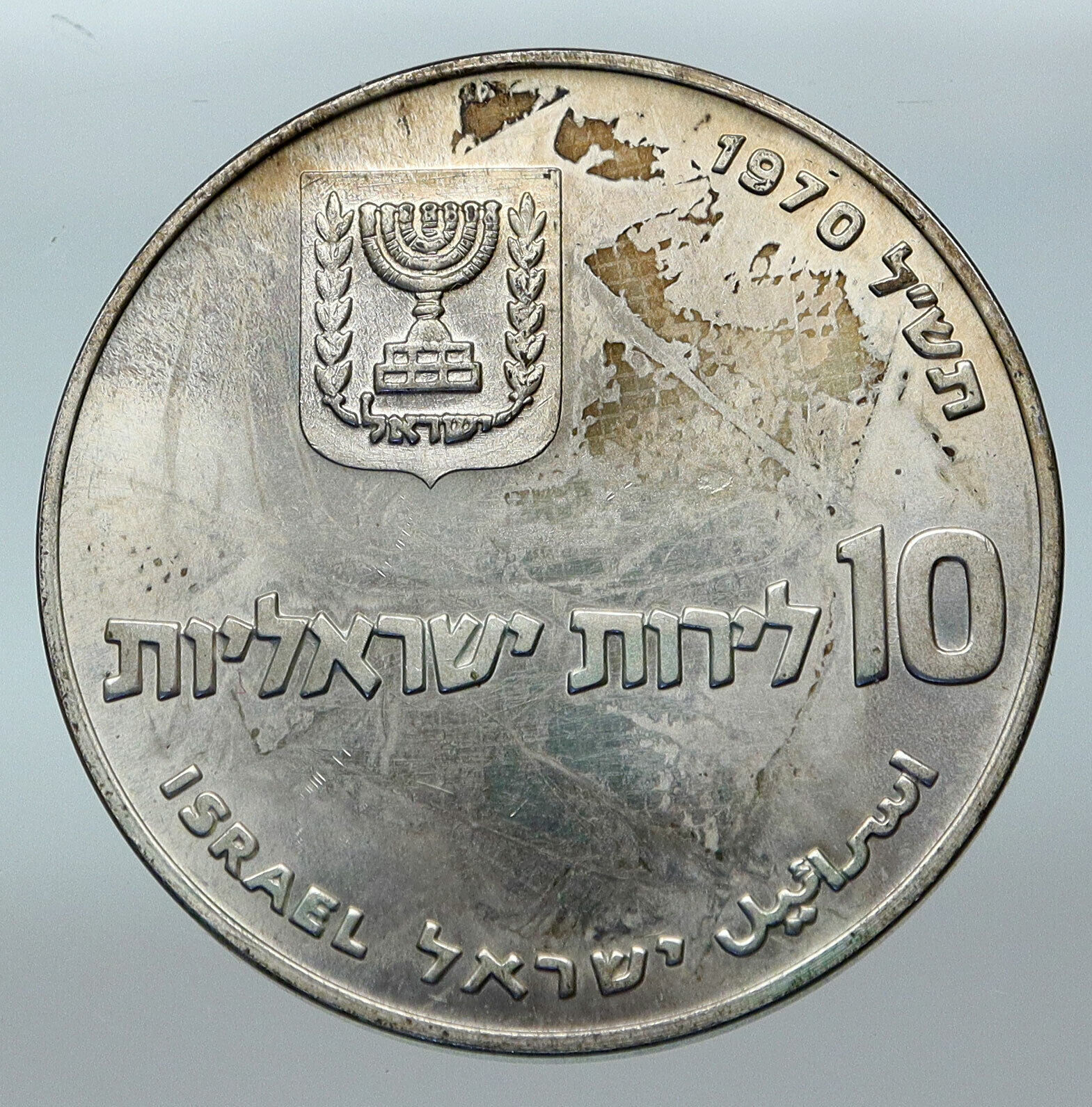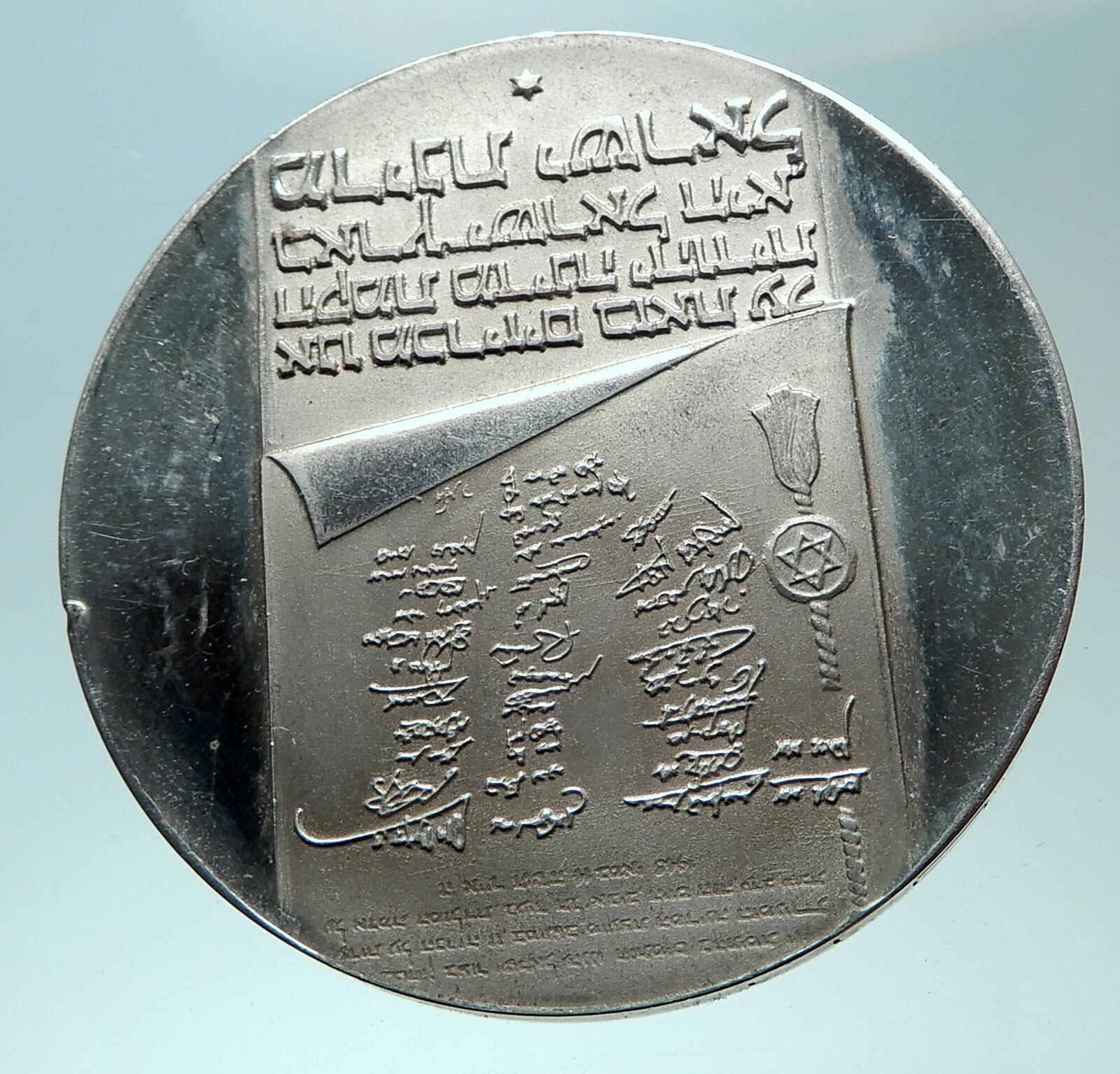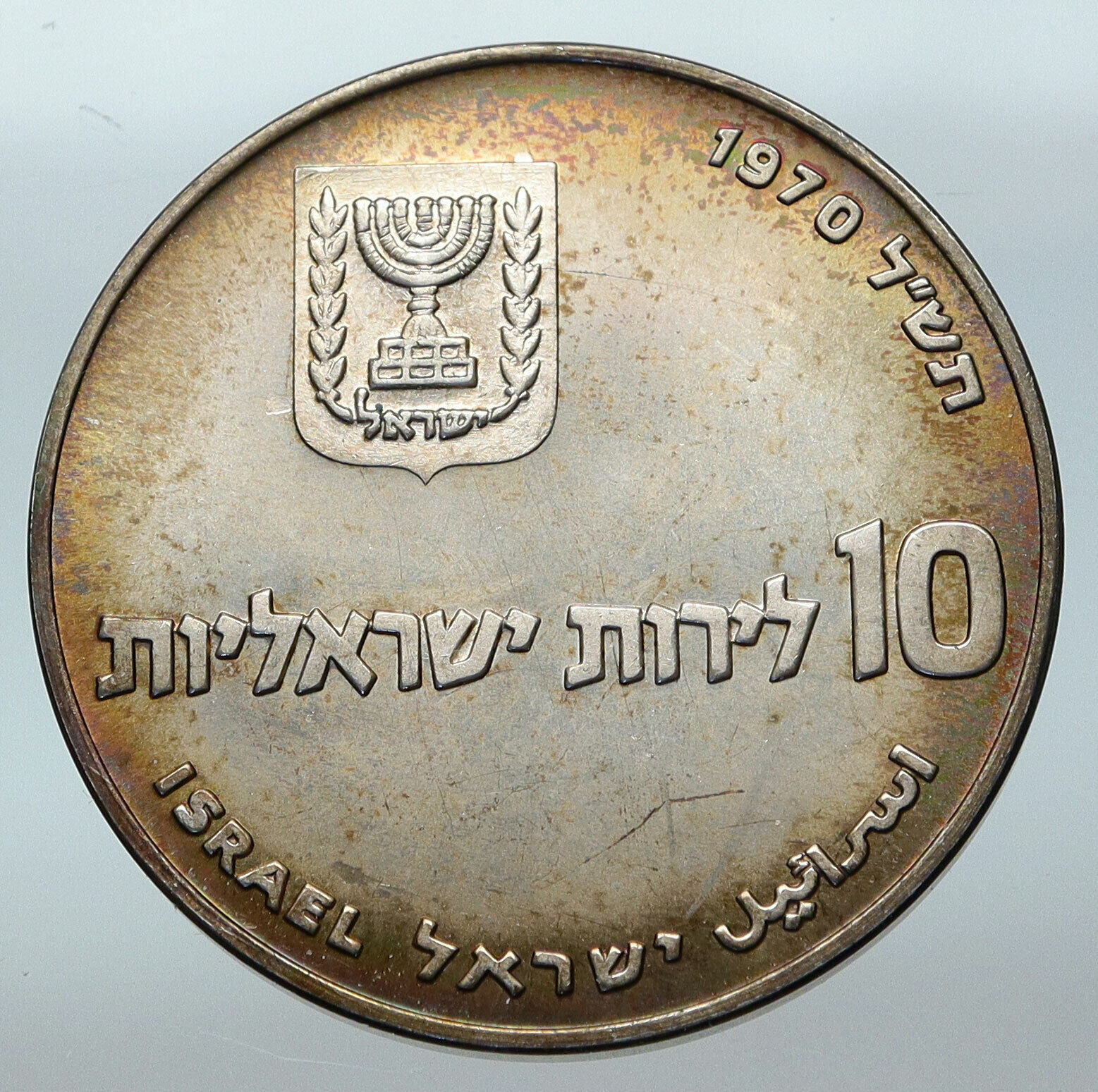|
Israel – Hanukkah – United States Design Lamp
1976 Proof Silver 10 Lirot 34mm (20.00 grams) 0.500 Silver (0.3215 oz. ASW)
Reference: KM# 84
EARLY ARMERICAN HANUKKA LAMP, U.S. Menorah Lamp.
اسرائيل ISRAEL 10, Boxed denomination center, Seal of Israel below.
You are bidding on the exact item pictured, provided with a Certificate of Authenticity and Lifetime Guarantee of Authenticity.
 The Hanukkah menorah, also chanukiah or hanukkiah (Hebrew: מנורת חנוכה menorat ḥanukkah, pl. menorot; also Hebrew: חַנֻכִּיָּה ḥanukkiyah, or chanukkiyah, pl. ḥanukkiyot/chanukkiyot, or Yiddish: חנוכּה לאָמפּ khanike lomp, lit.: Hanukkah lamp), is a nine-branched candelabrum lit during the eight-day holiday of Hanukkah, as opposed to the seven-branched menorah used in the ancient Temple or as a symbol. The Hanukkah menorah, also chanukiah or hanukkiah (Hebrew: מנורת חנוכה menorat ḥanukkah, pl. menorot; also Hebrew: חַנֻכִּיָּה ḥanukkiyah, or chanukkiyah, pl. ḥanukkiyot/chanukkiyot, or Yiddish: חנוכּה לאָמפּ khanike lomp, lit.: Hanukkah lamp), is a nine-branched candelabrum lit during the eight-day holiday of Hanukkah, as opposed to the seven-branched menorah used in the ancient Temple or as a symbol.
On each night of Hanukkah, a new branch is lit. The ninth holder, called the shamash (“helper” or “servant”), is for a candle used to light all other candles or to be used as an extra light. To be kosher, the shamash must be offset on a higher or lower plane than the main eight candles or oil lamps, but there are differing opinions as to whether all the lights must be arranged in a straight line, or if the chanukiah can be arranged in a curve.
The hanukkiah, along with the seven-branched menorah and the Star of David, is among the most widely produced articles of Jewish ceremonial art.
 The hanukkiah is often displayed in public around Hanukkah time in December. Elected officials often participate in publicly lighting the hanukkiah. The Chabad-Lubavitch movement is well associated with public lighting ceremonies, which it has done since a directive from their last Rebbe, Menachem Mendel Schneerson, in 1987. In the book A Kosher Christmas: ‘Tis the Season to Be Jewish,author Rabbi Joshua Plaut, Ph.D. details the history of public displays of the hanukkiah across the United States, summarizes the court cases associated with this issue, and explains how Presidents of the United States came to embrace lighting the hanukkiah during Hanukkah. The hanukkiah is often displayed in public around Hanukkah time in December. Elected officials often participate in publicly lighting the hanukkiah. The Chabad-Lubavitch movement is well associated with public lighting ceremonies, which it has done since a directive from their last Rebbe, Menachem Mendel Schneerson, in 1987. In the book A Kosher Christmas: ‘Tis the Season to Be Jewish,author Rabbi Joshua Plaut, Ph.D. details the history of public displays of the hanukkiah across the United States, summarizes the court cases associated with this issue, and explains how Presidents of the United States came to embrace lighting the hanukkiah during Hanukkah.
,_France_-_Musée_d'art_et_d'histoire_du_Judaïsme.jpg/220px-14th_century_Hannukah_lamp_(hanukiah),_France_-_Musée_d'art_et_d'histoire_du_Judaïsme.jpg) Since 1979, the White House has been represented at the lighting of the National Menorah in celebration of Hanukkah, beginning with the attendance of President Jimmy Carter in the ceremony in Lafayette Park. Additionally, beginning with President Bill Clinton in 1993, a hanukkiah is lit at the White House, and in 2001, President George W. Bush began the annual tradition of a White House Hanukkah Party in the White House residence, which includes a hanukkiah candle lighting ceremony. Since 1979, the White House has been represented at the lighting of the National Menorah in celebration of Hanukkah, beginning with the attendance of President Jimmy Carter in the ceremony in Lafayette Park. Additionally, beginning with President Bill Clinton in 1993, a hanukkiah is lit at the White House, and in 2001, President George W. Bush began the annual tradition of a White House Hanukkah Party in the White House residence, which includes a hanukkiah candle lighting ceremony.
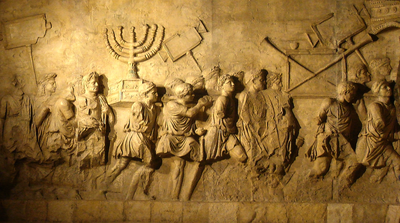 In the United Kingdom, the House of Commons of the United Kingdom each year holds a hanukkiah lighting at the official residence of the Speaker of the House of Commons, located in the Palace of Westminster. The hanukkiah currently used was commissioned by the Rt. Hon. Michael Martin MP, then Speaker of the House of Commons.Martin is a Roman Catholic; his successor, John Bercow, was coincidentally the first Jewish Speaker of the House of Commons. In the United Kingdom, the House of Commons of the United Kingdom each year holds a hanukkiah lighting at the official residence of the Speaker of the House of Commons, located in the Palace of Westminster. The hanukkiah currently used was commissioned by the Rt. Hon. Michael Martin MP, then Speaker of the House of Commons.Martin is a Roman Catholic; his successor, John Bercow, was coincidentally the first Jewish Speaker of the House of Commons.
 Two large hanukkiahs are in New York City, each standing at 32 feet. One is at Grand Army Plaza in Brooklyn, and the other is at Fifth Avenue and 59th Street in Manhattan near Central Park. A 4,000-pound structure, it is the work of Israeli artist Yaacov Agam. Because of the hanukkiah’s height, Con Edison assists the lighting by using a crane to lift each person to the top. Two large hanukkiahs are in New York City, each standing at 32 feet. One is at Grand Army Plaza in Brooklyn, and the other is at Fifth Avenue and 59th Street in Manhattan near Central Park. A 4,000-pound structure, it is the work of Israeli artist Yaacov Agam. Because of the hanukkiah’s height, Con Edison assists the lighting by using a crane to lift each person to the top.
 Israel (/ˈɪzriəl, ˈɪzreɪəl/; Hebrew: יִשְׂרָאֵל; Arabic: إِسْرَائِيل), officially the State of Israel, is a country in the Middle East, on the southeastern shore of the Mediterranean Sea and the northern shore of the Red Sea. It has land borders with Lebanon to the north, Syria to the northeast, Jordan on the east, the Palestinian territories of the West Bank and Gaza Strip to the east and west, respectively, and Egypt to the southwest. The country contains geographically diverse features within its relatively small area. Israel’s economic and technological center is Tel Aviv, while its seat of government and proclaimed capital is Jerusalem, although the state’s sovereignty over Jerusalem has only partial recognition. Israel (/ˈɪzriəl, ˈɪzreɪəl/; Hebrew: יִשְׂרָאֵל; Arabic: إِسْرَائِيل), officially the State of Israel, is a country in the Middle East, on the southeastern shore of the Mediterranean Sea and the northern shore of the Red Sea. It has land borders with Lebanon to the north, Syria to the northeast, Jordan on the east, the Palestinian territories of the West Bank and Gaza Strip to the east and west, respectively, and Egypt to the southwest. The country contains geographically diverse features within its relatively small area. Israel’s economic and technological center is Tel Aviv, while its seat of government and proclaimed capital is Jerusalem, although the state’s sovereignty over Jerusalem has only partial recognition.

Israel has evidence of the earliest migration of hominids out of Africa. Canaanite tribes are archaeologically attested since the Middle Bronze Age, while the Kingdoms of Israel and Judah emerged during the Iron Age. The Neo-Assyrian Empire destroyed Israel around 720 BCE. Judah was later conquered by the Babylonian, Persian and Hellenistic empires and had existed as Jewish autonomous provinces. The successful Maccabean Revolt led to an independent Hasmonean kingdom by 110 BCE, which in 63 BCE however became a client state of the Roman Republic that subsequently installed the Herodian dynasty in 37 BCE, and in 6 CE created the Roman province of Judea. Judea lasted as a Roman province until the failed Jewish revolts resulted in widespread destruction, expulsion of Jewish population and the renaming of the region from Iudaea to Syria Palaestina.[34] Jewish presence in the region has persisted to a certain extent over the centuries. In the 7th century the Levant was taken from the Byzantine Empire by the Arabs and remained in Muslim control until the First Crusade of 1099, followed by the Ayyubid conquest of 1187. The Mamluk Sultanate of Egypt extended its control over the Levant in the 13th century until its defeat by the Ottoman Empire in 1517. During the 19th century, national awakening among Jews led to the establishment of the Zionist movement in the diaspora followed by waves of immigration to Ottoman and later British Palestine.
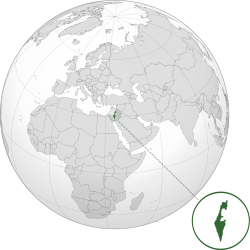 In 1947, the United Nations adopted a Partition Plan for Palestine recommending the creation of independent Arab and Jewish states and an internationalized Jerusalem. The plan was accepted by the Jewish Agency, and rejected by Arab leaders. The following year, the Jewish Agency declared the independence of the State of Israel, and the subsequent 1948 Arab-Israeli War saw Israel’s establishment over most of the former Mandate territory, while the West Bank and Gaza were held by neighboring Arab states. Israel has since fought several wars with Arab countries, and it has since 1967 occupied territories including the West Bank, Golan Heights and the Gaza Strip (still considered occupied after 2005 disengagement, although some legal experts dispute this claim). It extended its laws to the Golan Heights and East Jerusalem, but not the West Bank. Israel’s occupation of the Palestinian territories is the world’s longest military occupation in modern times. Efforts to resolve the Israeli-Palestinian conflict have not resulted in a final peace agreement. However, peace treaties between Israel and both Egypt and Jordan have been signed. In 1947, the United Nations adopted a Partition Plan for Palestine recommending the creation of independent Arab and Jewish states and an internationalized Jerusalem. The plan was accepted by the Jewish Agency, and rejected by Arab leaders. The following year, the Jewish Agency declared the independence of the State of Israel, and the subsequent 1948 Arab-Israeli War saw Israel’s establishment over most of the former Mandate territory, while the West Bank and Gaza were held by neighboring Arab states. Israel has since fought several wars with Arab countries, and it has since 1967 occupied territories including the West Bank, Golan Heights and the Gaza Strip (still considered occupied after 2005 disengagement, although some legal experts dispute this claim). It extended its laws to the Golan Heights and East Jerusalem, but not the West Bank. Israel’s occupation of the Palestinian territories is the world’s longest military occupation in modern times. Efforts to resolve the Israeli-Palestinian conflict have not resulted in a final peace agreement. However, peace treaties between Israel and both Egypt and Jordan have been signed.
In its Basic Laws, Israel defines itself as a Jewish and democratic state. Israel is a representative democracy with a parliamentary system, proportional representation and universal suffrage. The prime minister is head of government and the Knesset is the legislature. Israel is a developed country and an OECD member, with the 32nd-largest economy in the world by nominal gross domestic product as of 2017. The country benefits from a highly skilled workforce and is among the most educated countries in the world with one of the highest percentages of its citizens holding a tertiary education degree. Israel has the highest standard of living in the Middle East, and has one of the highest life expectancies in the world.
|









 The Hanukkah menorah, also chanukiah or hanukkiah (Hebrew: מנורת חנוכה menorat ḥanukkah, pl. menorot; also Hebrew: חַנֻכִּיָּה ḥanukkiyah, or chanukkiyah, pl. ḥanukkiyot/chanukkiyot, or Yiddish: חנוכּה לאָמפּ khanike lomp, lit.: Hanukkah lamp), is a nine-branched candelabrum lit during the eight-day holiday of Hanukkah, as opposed to the seven-branched menorah used in the ancient Temple or as a symbol.
The Hanukkah menorah, also chanukiah or hanukkiah (Hebrew: מנורת חנוכה menorat ḥanukkah, pl. menorot; also Hebrew: חַנֻכִּיָּה ḥanukkiyah, or chanukkiyah, pl. ḥanukkiyot/chanukkiyot, or Yiddish: חנוכּה לאָמפּ khanike lomp, lit.: Hanukkah lamp), is a nine-branched candelabrum lit during the eight-day holiday of Hanukkah, as opposed to the seven-branched menorah used in the ancient Temple or as a symbol.  The hanukkiah is often displayed in public around Hanukkah time in December. Elected officials often participate in publicly lighting the hanukkiah. The Chabad-Lubavitch movement is well associated with public lighting ceremonies, which it has done since a directive from their last Rebbe, Menachem Mendel Schneerson, in 1987. In the book A Kosher Christmas: ‘Tis the Season to Be Jewish,author Rabbi Joshua Plaut, Ph.D. details the history of public displays of the hanukkiah across the United States, summarizes the court cases associated with this issue, and explains how Presidents of the United States came to embrace lighting the hanukkiah during Hanukkah.
The hanukkiah is often displayed in public around Hanukkah time in December. Elected officials often participate in publicly lighting the hanukkiah. The Chabad-Lubavitch movement is well associated with public lighting ceremonies, which it has done since a directive from their last Rebbe, Menachem Mendel Schneerson, in 1987. In the book A Kosher Christmas: ‘Tis the Season to Be Jewish,author Rabbi Joshua Plaut, Ph.D. details the history of public displays of the hanukkiah across the United States, summarizes the court cases associated with this issue, and explains how Presidents of the United States came to embrace lighting the hanukkiah during Hanukkah. ,_France_-_Musée_d'art_et_d'histoire_du_Judaïsme.jpg/220px-14th_century_Hannukah_lamp_(hanukiah),_France_-_Musée_d'art_et_d'histoire_du_Judaïsme.jpg) Since 1979, the White House has been represented at the lighting of the National Menorah in celebration of Hanukkah, beginning with the attendance of President Jimmy Carter in the ceremony in Lafayette Park. Additionally, beginning with President Bill Clinton in 1993, a hanukkiah is lit at the White House, and in 2001, President George W. Bush began the annual tradition of a White House Hanukkah Party in the White House residence, which includes a hanukkiah candle lighting ceremony.
Since 1979, the White House has been represented at the lighting of the National Menorah in celebration of Hanukkah, beginning with the attendance of President Jimmy Carter in the ceremony in Lafayette Park. Additionally, beginning with President Bill Clinton in 1993, a hanukkiah is lit at the White House, and in 2001, President George W. Bush began the annual tradition of a White House Hanukkah Party in the White House residence, which includes a hanukkiah candle lighting ceremony.  In the United Kingdom, the House of Commons of the United Kingdom each year holds a hanukkiah lighting at the official residence of the Speaker of the House of Commons, located in the Palace of Westminster. The hanukkiah currently used was commissioned by the Rt. Hon. Michael Martin MP, then Speaker of the House of Commons.Martin is a Roman Catholic; his successor, John Bercow, was coincidentally the first Jewish Speaker of the House of Commons.
In the United Kingdom, the House of Commons of the United Kingdom each year holds a hanukkiah lighting at the official residence of the Speaker of the House of Commons, located in the Palace of Westminster. The hanukkiah currently used was commissioned by the Rt. Hon. Michael Martin MP, then Speaker of the House of Commons.Martin is a Roman Catholic; his successor, John Bercow, was coincidentally the first Jewish Speaker of the House of Commons.  Two large hanukkiahs are in New York City, each standing at 32 feet. One is at Grand Army Plaza in Brooklyn, and the other is at Fifth Avenue and 59th Street in Manhattan near Central Park. A 4,000-pound structure, it is the work of Israeli artist Yaacov Agam. Because of the hanukkiah’s height, Con Edison assists the lighting by using a crane to lift each person to the top.
Two large hanukkiahs are in New York City, each standing at 32 feet. One is at Grand Army Plaza in Brooklyn, and the other is at Fifth Avenue and 59th Street in Manhattan near Central Park. A 4,000-pound structure, it is the work of Israeli artist Yaacov Agam. Because of the hanukkiah’s height, Con Edison assists the lighting by using a crane to lift each person to the top.  Israel (/ˈɪzriəl, ˈɪzreɪəl/; Hebrew: יִשְׂרָאֵל; Arabic: إِسْرَائِيل), officially the State of Israel, is a country in the Middle East, on the southeastern shore of the Mediterranean Sea and the northern shore of the Red Sea. It has land borders with Lebanon to the north, Syria to the northeast, Jordan on the east, the Palestinian territories of the West Bank and Gaza Strip to the east and west, respectively, and Egypt to the southwest. The country contains geographically diverse features within its relatively small area. Israel’s economic and technological center is Tel Aviv, while its seat of government and proclaimed capital is Jerusalem, although the state’s sovereignty over Jerusalem has only partial recognition.
Israel (/ˈɪzriəl, ˈɪzreɪəl/; Hebrew: יִשְׂרָאֵל; Arabic: إِسْرَائِيل), officially the State of Israel, is a country in the Middle East, on the southeastern shore of the Mediterranean Sea and the northern shore of the Red Sea. It has land borders with Lebanon to the north, Syria to the northeast, Jordan on the east, the Palestinian territories of the West Bank and Gaza Strip to the east and west, respectively, and Egypt to the southwest. The country contains geographically diverse features within its relatively small area. Israel’s economic and technological center is Tel Aviv, while its seat of government and proclaimed capital is Jerusalem, although the state’s sovereignty over Jerusalem has only partial recognition.
 In 1947, the United Nations adopted a Partition Plan for Palestine recommending the creation of independent Arab and Jewish states and an internationalized Jerusalem. The plan was accepted by the Jewish Agency, and rejected by Arab leaders. The following year, the Jewish Agency declared the independence of the State of Israel, and the subsequent 1948 Arab-Israeli War saw Israel’s establishment over most of the former Mandate territory, while the West Bank and Gaza were held by neighboring Arab states. Israel has since fought several wars with Arab countries, and it has since 1967 occupied territories including the West Bank, Golan Heights and the Gaza Strip (still considered occupied after 2005 disengagement, although some legal experts dispute this claim). It extended its laws to the Golan Heights and East Jerusalem, but not the West Bank. Israel’s occupation of the Palestinian territories is the world’s longest military occupation in modern times. Efforts to resolve the Israeli-Palestinian conflict have not resulted in a final peace agreement. However, peace treaties between Israel and both Egypt and Jordan have been signed.
In 1947, the United Nations adopted a Partition Plan for Palestine recommending the creation of independent Arab and Jewish states and an internationalized Jerusalem. The plan was accepted by the Jewish Agency, and rejected by Arab leaders. The following year, the Jewish Agency declared the independence of the State of Israel, and the subsequent 1948 Arab-Israeli War saw Israel’s establishment over most of the former Mandate territory, while the West Bank and Gaza were held by neighboring Arab states. Israel has since fought several wars with Arab countries, and it has since 1967 occupied territories including the West Bank, Golan Heights and the Gaza Strip (still considered occupied after 2005 disengagement, although some legal experts dispute this claim). It extended its laws to the Golan Heights and East Jerusalem, but not the West Bank. Israel’s occupation of the Palestinian territories is the world’s longest military occupation in modern times. Efforts to resolve the Israeli-Palestinian conflict have not resulted in a final peace agreement. However, peace treaties between Israel and both Egypt and Jordan have been signed. 

